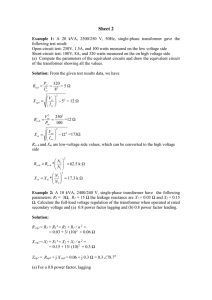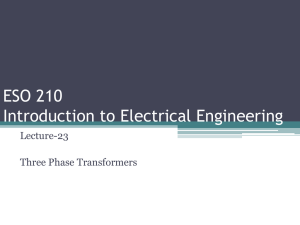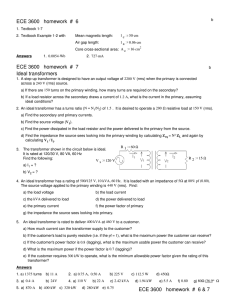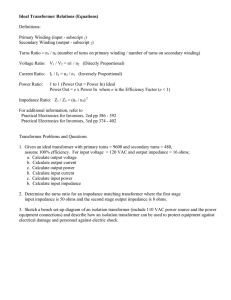File
advertisement
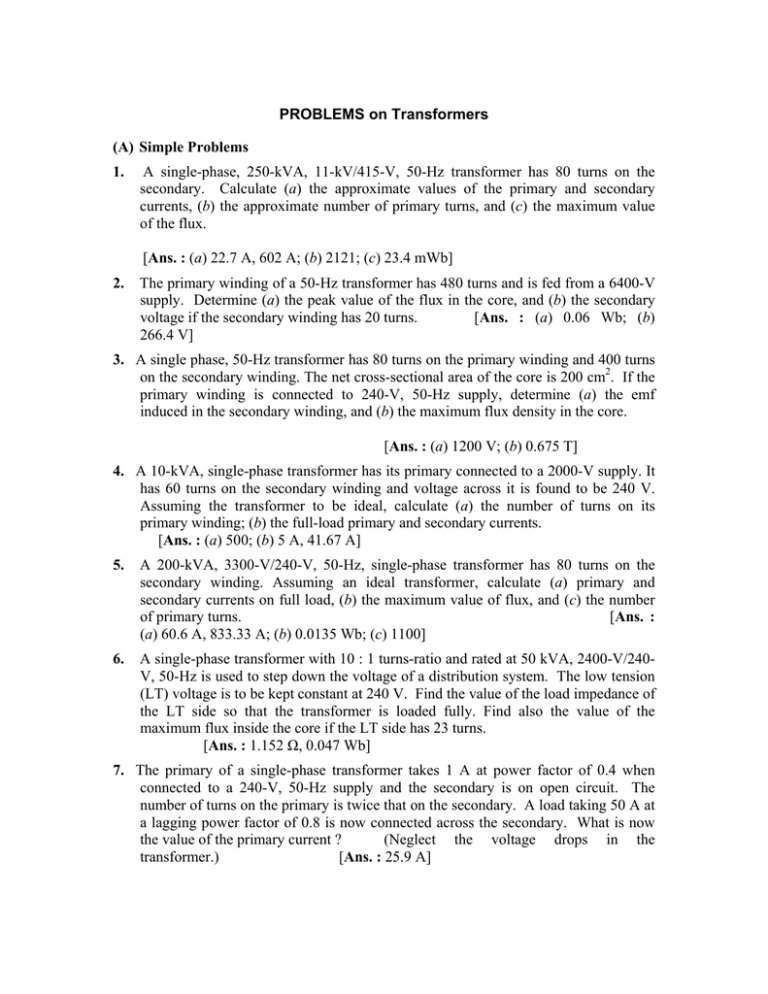
PROBLEMS on Transformers (A) Simple Problems 1. A single-phase, 250-kVA, 11-kV/415-V, 50-Hz transformer has 80 turns on the secondary. Calculate (a) the approximate values of the primary and secondary currents, (b) the approximate number of primary turns, and (c) the maximum value of the flux. [Ans. : (a) 22.7 A, 602 A; (b) 2121; (c) 23.4 mWb] 2. The primary winding of a 50-Hz transformer has 480 turns and is fed from a 6400-V supply. Determine (a) the peak value of the flux in the core, and (b) the secondary voltage if the secondary winding has 20 turns. [Ans. : (a) 0.06 Wb; (b) 266.4 V] 3. A single phase, 50-Hz transformer has 80 turns on the primary winding and 400 turns on the secondary winding. The net cross-sectional area of the core is 200 cm2. If the primary winding is connected to 240-V, 50-Hz supply, determine (a) the emf induced in the secondary winding, and (b) the maximum flux density in the core. [Ans. : (a) 1200 V; (b) 0.675 T] 4. A 10-kVA, single-phase transformer has its primary connected to a 2000-V supply. It has 60 turns on the secondary winding and voltage across it is found to be 240 V. Assuming the transformer to be ideal, calculate (a) the number of turns on its primary winding; (b) the full-load primary and secondary currents. [Ans. : (a) 500; (b) 5 A, 41.67 A] 5. A 200-kVA, 3300-V/240-V, 50-Hz, single-phase transformer has 80 turns on the secondary winding. Assuming an ideal transformer, calculate (a) primary and secondary currents on full load, (b) the maximum value of flux, and (c) the number of primary turns. [Ans. : (a) 60.6 A, 833.33 A; (b) 0.0135 Wb; (c) 1100] 6. A single-phase transformer with 10 : 1 turns-ratio and rated at 50 kVA, 2400-V/240V, 50-Hz is used to step down the voltage of a distribution system. The low tension (LT) voltage is to be kept constant at 240 V. Find the value of the load impedance of the LT side so that the transformer is loaded fully. Find also the value of the maximum flux inside the core if the LT side has 23 turns. [Ans. : 1.152 Ω, 0.047 Wb] 7. The primary of a single-phase transformer takes 1 A at power factor of 0.4 when connected to a 240-V, 50-Hz supply and the secondary is on open circuit. The number of turns on the primary is twice that on the secondary. A load taking 50 A at a lagging power factor of 0.8 is now connected across the secondary. What is now the value of the primary current ? (Neglect the voltage drops in the transformer.) [Ans. : 25.9 A] 8. A single-phase, 50-Hz transformer has 100 turns on the primary winding and 400 turns on the secondary winding. The net cross-sectional area of the core is 250 cm2. If the primary winding is connected to a 50-Hz, 230-V supply, calculate (a) the emf induced in the secondary winding, and (b) the maximum value of the flux density in the core. [Ans. : (a) 920 V; (b) 0.414 T] 9. The no-load current of a single-phase transformer is 5.0 A at 0.3 power factor when supplied from a 240-V, 50-Hz source. The number of turns on the primary is 200. Calculate (a) the maximum value of the flux in the core, (b) the core losses, and (c) the magnetizing current. [Ans. : (a) 5.4 mWb; (b) 360 W; (c) 4.77 A] 10. A transformer on no-load takes 1.5 A at a power factor of 0.2 lagging when its primary is connected to a 50-Hz, 230-V supply. Its transformation ratio (N2/N1) is 1/3. Determine the primary current when the secondary is supplying a current of 300 A at a power factor of 0.8 lagging. Neglect the voltage drops in the windings. [Ans. : 14.5 A] 11. The no-load current of a 50-Hz, 230-V transformer is 4.5 A at a power factor of 0.25 lagging. The number of turns on the primary winding is 250. Calculate (a) the magnetizing current, (b) the core loss, and (c) the maximum value of the flux in the core. [Ans. : (a) 4.35 A; (b) 258.75 W; (c) 4.14 mWb] 12. A 100-kVA transformer has 400 turns on the primary and 80 turns on the secondary winding. The primary and secondary resistances are 0.3 Ω and 0.1 Ω, respectively. The primary and secondary leakage reactances are 1.1 Ω and 0.035 Ω, respectively. Calculate the equivalent impedance referred to the primary side. [Ans. : 3.426 Ω] 13. A single-phase, 100-kVA, 1100-V/220-V transformer has following parameters : R1 = 0.1 Ω, X1 = 0.3 Ω, R2 = 0.004 Ω and X2 = 0.012 Ω. Determine (a) the equivalent resistance and leakage reactance as referred to the high voltage winding, and (b) the equivalent resistance and leakage reactance as referred to the low voltage winding. [Ans. : (a) 0.2 Ω, 0.6 Ω; (b) 0.008 Ω, 0.024 Ω] 14. In a 50-kVA, 11-kV/400-V, single-phase transformer, the iron and copper losses are 500 W and 600 W, respectively under rated conditions. Calculate (a) the efficiency at unity power factor at full load, (b) the load for maximum efficiency, and (c) the iron and copper losses for this load. [Ans. : (a) 97.85 %; (b) 45.64 kVA; (c) 500 W, 500 W] 15. A 10-kVA, 200-V/400-V, 50-Hz, single-phase transformer gave the following testresults : OC test (HV winding open) : 200 V, 1.3 A, 120 W. SC test (LV winding shorted) : 22 V, 30 A, 200 W. Calculate (a) the magnetizing current, and (b) the equivalent resistance and leakage reactance as referred to the low voltage side. [Ans. : (a) 1.15 A; (b) 0.0555 Ω, 0.1745 Ω] (B) Tricky Problems 16. A single-phase, 50-Hz transformer has 30 turns on primary and 350 turns on secondary. The net cross-sectional area of the core is 250 cm2. If the primary winding is connected to a 230-V, 50-Hz supply, calculate (a) peak value of the flux density in the core, (b) the voltage induced in the secondary winding, and (c) the primary current when the secondary current is 100 A. Neglect the losses. [Ans. : (a) 1.3814 T; (b) 2683.33 V; (c) 1166.67 A] 17. A single-phase, 50-Hz, 100-kVA, 2400-V/240-V transformer has no-load current of 0.64 A and core loss of 700 W, when its high voltage (HV) side is energized at rated voltage and frequency. Calculate the two components of the no-load current. If this transformer supplies a load current of 40 A at 0.8 lagging pf on its low voltage side, determine the primary current and its power factor. Ignore the resistance and leakage reactance drops. [Ans. : 0.5697 A, 0.2917 A; 4.584 A, 0.762 lagging] 18. An ideal 50-Hz, core-type transformer has 100 primary-turns and 200 secondaryturns. The primary rated voltage is 220 V. If the maximum permissible flux density is 1.2 T, what should be the cross-sectional area ? Also, find (a) the secondary voltage, and (b) the primary current in complex form with reference to the secondary voltage vector when secondary delivers a current of 8 A at a lagging power factor of 0.8. [Ans. : 8.26 × 10−3 m 2 ;(a) 440 V; (b) 16∠143.1° A ] 19. A 500-kVA, 11000-V/400-V, 50-Hz, single-phase transformer has 100 turns on the secondary winding. Calculate (a) the approximate number of turns on the primary winding, (b) the approximate values of the primary and secondary current, and (c) the maximum value of the flux in the core. [Ans. : (a) 2750; (b) 45.45 A, 1250 A; (c) 0.018 Wb] 20. A single-phase transformer has a turns-ratio of 144/432 and operates at a maximum flux of 7.5 mWb at 50 Hz. When working on no load, it takes 0.24 kVA at a power factor of 0.26 lagging from the supply. If it supplies a load of 1.2 kVA at a power factor of 0.8 lagging, determine (a) the magnetizing current, (b) the primary current, and (c) the primary power factor. [Ans. : (a) 0.97 A; (b) 5.8 A; (c) 0.731 lagging] 21. The primary and secondary windings of a 30-kVA, 6000-V/230-V, single-phase transformer have resistances of 10 Ω and 0.0016 Ω, respectively. The total reactance of the transformer as referred to the primary side is 23 Ω. Calculate the percentage regulation of the transformer when supplying full-load current at a power factor of 0.8 lagging. [Ans. : 2.54 %] 22. A transformer with turns-ratio 8 : 1, has the resistances of the primary and secondary windings as 0.85 Ω and 0.012 Ω respectively, and the leakage reactances as 4.8 Ω and 0.07 Ω respectively. Determine the voltage to be applied to the primary to obtain a current of 150 A in the secondary when the secondary terminals are shortcircuited. Ignore the magnetizing current. [Ans. : 176.6 V] 23. A single-phase, 50-Hz transformer has a turns ratio 6 : 1. The primary and secondary winding resistances are 0.90 Ω and 0.03 Ω respectively, and leakage reactances are 5 Ω and 0.13 Ω respectively. Find (a) the voltage to be applied to the high voltage side to get a current of 100 A in the low voltage winding on shortcircuit, and (b) the primary power factor on short-circuit. Neglect the no-load current. [Ans. : (a) 164.67 V; (b) 0.2 lagging] 24. For the transformer in Prob. 26, assuming the power factor to be 0.8, find the output at which the efficiency is maximum and calculate its value. [Ans. : 447 kVA, 98.4 %] (C) Challenging Prolems 25. A single-phase transformer has Z1 = (1.4 + j 5.2) Ω and Z 2 = (0.0117 + j 0.0465) Ω . The input voltage is 6600 V and turns-ratio is 10.6 : 1. The secondary feeds a load which draws 300 A at 0.8 power factor lagging. Neglecting no-load current I0, determine the secondary voltage and the output in kW. [Ans. : 600 V, 144 kW] 26. A single-phase, 10-kVA, 4000-V/400-V transformer has following parameters : R1 = 13 Ω, X1 = 20 Ω, R2 = 0.15 Ω, X2 = 0.25 Ω, R0 = 12000 Ω and X0 = 6000 Ω. Determine (a) the equivalent resistance and leakage reactance as referred to the primary winding, (b) the input current with secondary terminals open-circuited, and (c) the input current when the secondary supplies a load current of 25 A at a power of 0.8 lagging. [Ans. : (a) 28 Ω, 45 Ω; (b) 0.745∠ − 63.5° A ; (c) 3.18∠ − 42.9° A ] 27. A single-phase, 200-V/2000-V transformer is fed from a 200-V supply. The equivalent winding resistance and leakage reactance as referred to the low voltage side are 0.16 Ω and 0.7 Ω, respectively. The resistance representing core losses is 400 Ω and the magnetizing reactance is 231 Ω. A load impedance of ZL = (596 + j444) Ω is connected across the secondary terminals. Calculate (a) the input current, (b) the secondary terminal voltage, and (c) the primary power factor. 25.96∠ − 40.78° A ; (b) 1859 V; (c) 0.757 lagging] [Ans. : (a) 28. A single-phase, 100-kVA, 2000-V/200-V, 50-Hz transformer has impedance drop of 10 % and resistance drop of 5 %. (a) What is the regulation at full-load 0.8 power factor lagging ? (b) At what power factor is the regulation zero ? [Ans. : (a) 9.196 %; (b) 0.866 leading] 29. The primary and secondary windings of a 500-kVA, 11-kV/415-V, single-phase transformer have resistances of 0.42 Ω and 0.0019 Ω, respectively. Its core losses are 2.9 kW. Assuming the power factor to be 0.8, calculate its efficiency on (a) full load, and (b) half load. [Ans. : (a) 98.39 %; (b) 98.13 %] 30. A single phase transformer has percentage regulations of 4 and 4.4 for lagging power factors of 0.8 and 0.6, respectively. The full-load copper loss is equal to the iron loss. Calculate (a) the lagging power factor at which the full-load regulation is maximum, and (b) the full-load efficiency at unity power factor. [Ans. : (a) 0.4472 lagging; (b) 96.15 %] 31. A 250-kVA, single-phase transformer has an efficiency of 96 % on full load at 0.8 power factor lagging and on half load 0.8 power factor lagging. Find iron loss and full-load copper loss. [Ans. : 2.78 kW, 5.56 kW]
